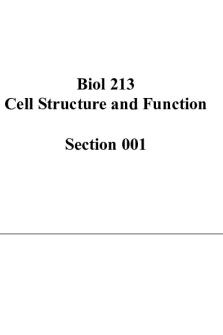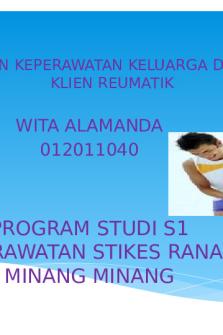power point presentation medulla oblongata PDF

| Title | power point presentation medulla oblongata |
|---|---|
| Course | Human Biological Science 1 |
| Institution | Australian Catholic University |
| Pages | 6 |
| File Size | 62.5 KB |
| File Type | |
| Total Downloads | 11 |
| Total Views | 162 |
Summary
presentation written...
Description
Running head: MEDULLA OBLONGATA
Medulla Oblongata Student’s Name Institutional Affiliation
1
MEDULLA OBLONGATA
2 Medulla Oblongata
The medulla oblongata connects the brainstem and spinal cord while housing several crucial functional centers through its fibers. It serves as the origin of cranial nerves IX through XII. It also houses the nucleus that regulates the cardiovascular and respiratory systems. Lastly, it houses the ascending sensory and descending motor tracts. The medulla is the site of decussation of motor neurons toward the contralateral or opposite side of the spinal cord. It is also the caudal-most part of the brainstem, and it is at the same level as the foramen magnum. At the anterior portion of the medulla oblongata lies the median fissure connecting it to the spinal cord. Its posterior surface divides into the inferior and superior parts. The former structure houses the median sulcus that is connected to the spinal cord, while the latter becomes the bottom wall of the fourth ventricle. The medulla is structurally divided into three laminae, the basis, tectum, and tegmentum. The basis is the ventral-most part of the medulla that houses the pyramidal decussation of fibers. The tectum accommodates the inferior medullary velum located at the posterior and inferiormost part of the fourth ventricle. Lastly, the tegmentum houses the cranial nerves IX through XII and the inferior olivary nucleus. The medulla is responsible for regulating the cardiovascular-respiratory function of the brainstem. The RVLM or rostral ventral lateral medulla contains excitatory neurons that carry the information of pre-sympathetic neurons from the spinal cord. These neurons are responsible for maintaining the baseline arterial pressure. The RVLM has a ventral respiratory column known as the control center for the respiratory pattern and rhythm. Furthermore, this structure regulates the oscillating pattern of respiration that allows oxygen perfusion into tissues (Iordanova and Reddivari, 2021).
MEDULLA OBLONGATA
3
The medulla also houses the solitary nucleus (NTS) that is located at its dorsolateral part from the caudal side of the facial nucleus toward the caudal section of the decussation at the pyramidal tract. The solitary nucleus analyzes and coordinates visceral afferent information (Iordanova and Reddivari, 2021). This nucleus in the medulla integrates and initiates the various reflexes that control cardiovascular activity, gastrointestinal motility, and respiration (CutsforthGregory and Benarroch, 2017). The other functional parts of the medulla include the area postrema that participates in the inhibition of vomiting from emetic drugs. The spinal trigeminal nucleus mediates pain, temperature, and crude touch sensations. The inferior olivary nuclei are responsible for proprioception, motor intention, and muscle tension. They also synapse onto the Purkinje cell bodies making their connections of great importance. The net-like reticular formation lies at the tegmentum part of the medulla. It participates in the autonomic regulation of heart rate, blood pressure, and respiration. The pyramidal decussation of the motor pathway forms the lateral corticospinal tract. The cuneate and Gracilis nucleus, medial lemniscus, and spinothalamic tract convey and carry information regarding conscious vibration, fine tactile discrimination, and proprioception. No one can live without the medulla oblongata. Its absence will impair the function of all the structures and organs innervated by the cranial nerves IX through XII. All the ascending and descending tracts that pass through the medulla will also be affected. There will also be a loss of several reflexes including, the salivary-taste reflex, carotid sinus reflex, carotid body reflex, cough reflex, gag reflex, and vomiting reflex. Furthermore, a person cannot exist without the medulla because the sites responsible for blood pressure regulation, respiration, neurological arousal, and cardiovascular activities are all located on this structure. Gali (2017) discussed the
MEDULLA OBLONGATA
4
importance of the pressor sites located in the caudal part of the medulla and cervical spinal cord. The absence of the medulla will put a gap in the integrated control of blood pressure. Without proper pressure control of the blood, no human can survive. Connolly, Gillingwater, Chandler, Grant, Greig, Meskell, Ross, Smith, Wood, and Finn (2018) tackled the importance of having a good understanding of bioscientific knowledge in its practical application. The knowledge of the anatomical location and the physiological function of the medulla oblongata helps in the integration of bioscientific knowledge into nursing principles. This knowledge also aids in the identification of clinical signs in patients and their risk diagnosis. In psychology, the knowledge of the medulla aids in the understanding of accompanying neurological symptoms among patients who are suffering from psychological disorders (K. Davila, personal communication, April 11, 2021). Its knowledge also aids in the understanding of concepts in the field, such as the reflex arc. In a review by Evrard, Gumpper, Beauvais, and Alvarado (2021), the importance of understanding concepts in physiology to better understand psychology was emphasized. Understanding the function and physiology of the medulla oblongata helps psychologists understand the etiology of some psychological disorders.
MEDULLA OBLONGATA
5 References
Connolly, S., Gillingwater, T., Chandler, C., Grant, A., Greig, J., & Meskell, M. et al. (2018). The Anatomical Society's core anatomy syllabus for undergraduate nursing. Journal Of Anatomy, 232(5), 721-728. doi: 10.1111/joa.12782 Cutsforth-Gregory, J., & Benarroch, E. (2017). Nucleus of the solitary tract, medullary reflexes, and clinical implications. Neurology, 88(12), 1187-1196. doi: 10.1212/wnl.0000000 000003751 Encyclopedia Britannica. (2021). Cerebellum: human brain [Image]. Retrived from https:// www.britannica.com/science/medulla-oblongata#/media/1/372788/59842 Evrard, R., Gumpper, S., Beauvais, B., & Alvarado, C. (2021). “Never sacrifice anything to laboratory work”: The “physiological psychology” of Charles Richet (1875–1905). Journal Of The History Of The Behavioral Sciences. doi: 10.1002/jhbs.22086 Ghali, M. (2017). The brainstem network controlling blood pressure. Journal Of Hypertension, 35(10), 1938-1947. doi: 10.1097/hjh.0000000000001427 Iordanova R, Reddivari AKR. Neuroanatomy, Medulla Oblongata. [Updated 2020 Jul 31]. In: StatPearls [Internet]. Treasure Island (FL): StatPearls Publishing; 2021 Jan-. Available from: https://www.ncbi.nlm.nih.gov/books/NBK551589/ Kumagai, H. (n.d.). Schematic drawing of the central and peripheral sympathetic nervous systems [Image]. Retrieved from https://www.nature.com/articles/hr2011208 McGinnis, W., Audhya, T., & Edelson, S. (n.d.). Area postrema [Image]. Retrieved from https://www.researchgate.net/figure/Area-Postrema-is-Anatomical-Marker-for-theSubregion-of-NTS-of-Primary-Hypothetical_fig1_259320952 Prado, M. (n.d.). Autonomic regulation of cardiac function [Image]. Retrieved from
MEDULLA OBLONGATA
6
https://www.researchgate.net/figure/Autonomic-regulation-of-cardiac-function-1Baroreceptors-in-the-carotid-arteries-and_fig1_265648676 Smith, D., & Boughter, J. (n.d.). Schematic diagram of the ascending and descending gustatory pathways [Image]. Retrieved from https://www.sciencedirect.com/topics/neuroscience/ solitary-tract Vascovic, J. (2021). Medulla Oblongata [Image]. Retrieved from https://www.kenhub.com/en/ library/anatomy/medulla-oblongata-gross-anatomy...
Similar Free PDFs

Medulla oblongata
- 4 Pages
![M6-Presentation [Power Point]](https://pdfedu.com/img/crop/172x258/7038md56vrew.jpg)
M6-Presentation [Power Point]
- 66 Pages

Power Point Outline
- 1 Pages

Power Point tanya - MEDICINA
- 6 Pages

power point Ascaris lumbricoides
- 19 Pages

Power point chapter 1
- 71 Pages

Power Point 1 Introduction
- 1 Pages

Power point rematik wita
- 7 Pages

POWER POINT IKATAN KIMIA
- 27 Pages

MODUL MICROSOFT POWER POINT
- 14 Pages

Power point BULLYING
- 7 Pages
Popular Institutions
- Tinajero National High School - Annex
- Politeknik Caltex Riau
- Yokohama City University
- SGT University
- University of Al-Qadisiyah
- Divine Word College of Vigan
- Techniek College Rotterdam
- Universidade de Santiago
- Universiti Teknologi MARA Cawangan Johor Kampus Pasir Gudang
- Poltekkes Kemenkes Yogyakarta
- Baguio City National High School
- Colegio san marcos
- preparatoria uno
- Centro de Bachillerato Tecnológico Industrial y de Servicios No. 107
- Dalian Maritime University
- Quang Trung Secondary School
- Colegio Tecnológico en Informática
- Corporación Regional de Educación Superior
- Grupo CEDVA
- Dar Al Uloom University
- Centro de Estudios Preuniversitarios de la Universidad Nacional de Ingeniería
- 上智大学
- Aakash International School, Nuna Majara
- San Felipe Neri Catholic School
- Kang Chiao International School - New Taipei City
- Misamis Occidental National High School
- Institución Educativa Escuela Normal Juan Ladrilleros
- Kolehiyo ng Pantukan
- Batanes State College
- Instituto Continental
- Sekolah Menengah Kejuruan Kesehatan Kaltara (Tarakan)
- Colegio de La Inmaculada Concepcion - Cebu




